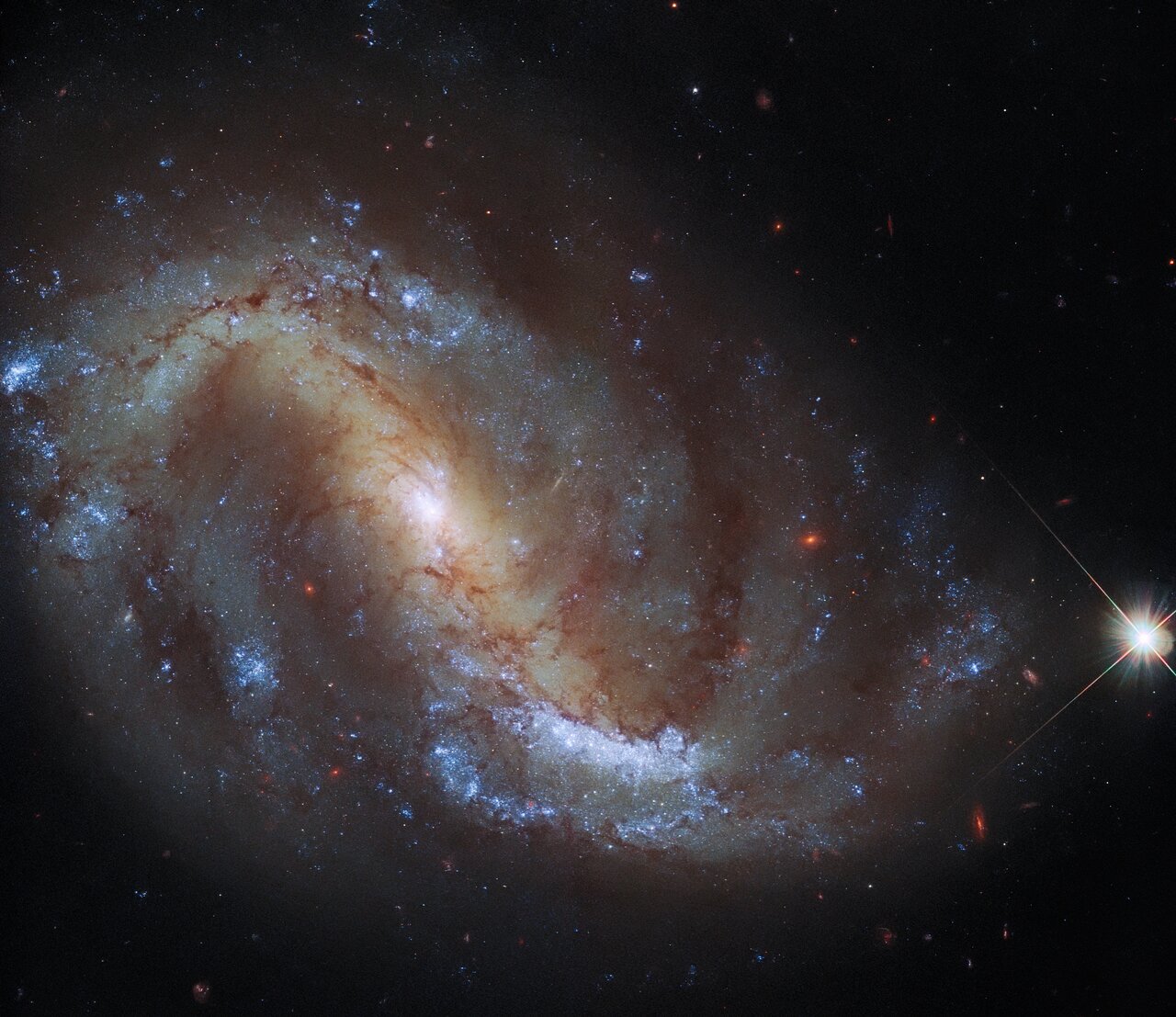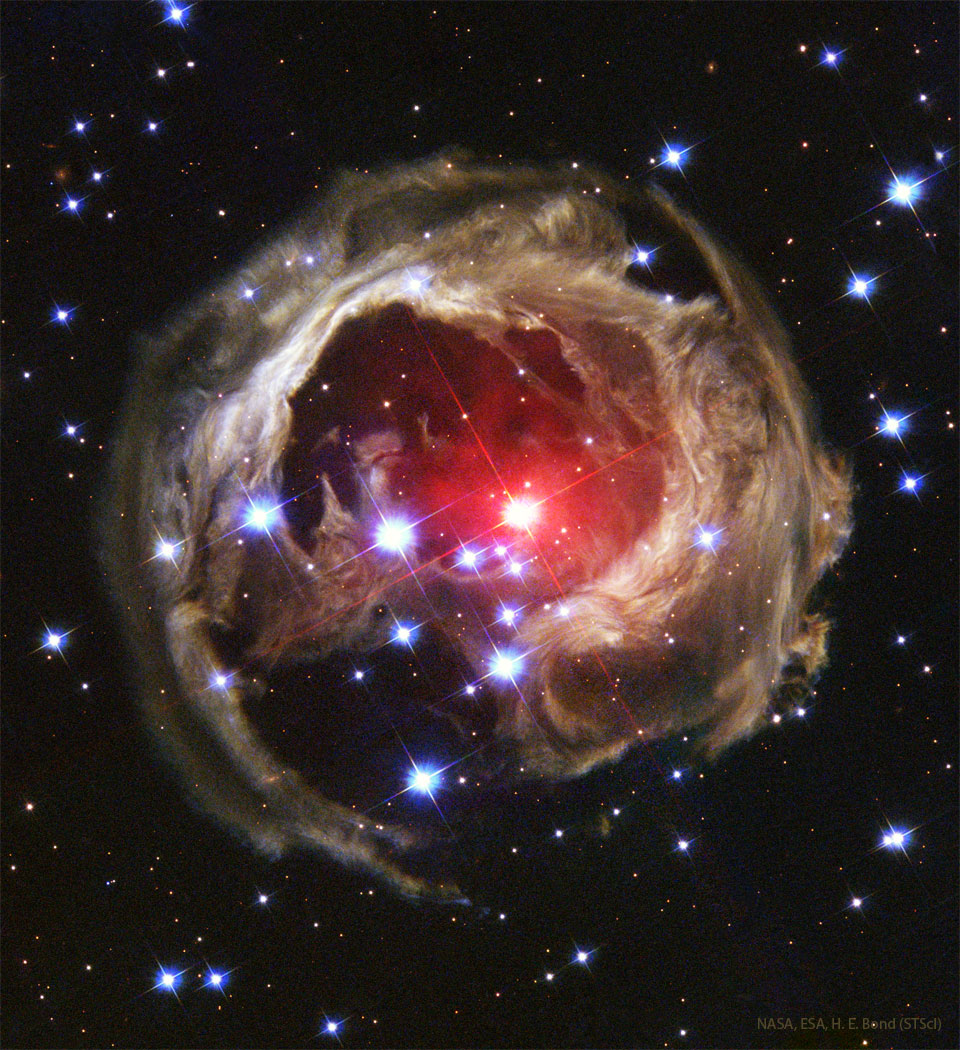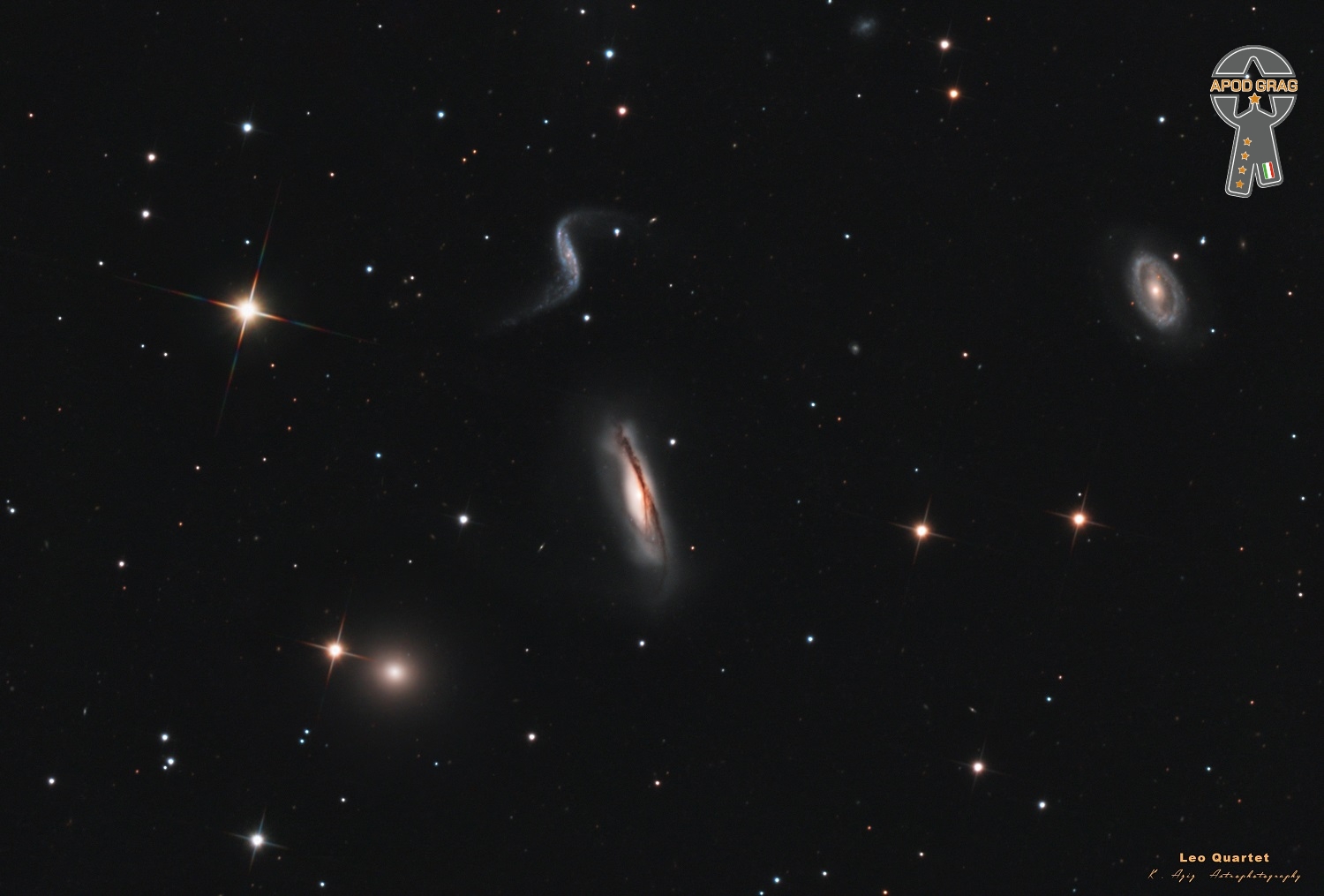Blog
This image from the NASA/ESA Hubble Space Telescope shows the barred spiral galaxy NGC 7496, which lies over 24 million light-years away in the constellation Grus. This constellation, whose name is Latin for crane, is one of four constellations collectively known as the Southern Birds. The others are Pavo, Phoenix and Tucana, which depict a peacock, phoenix, and toucan respectively. The rest of the night sky is also home to a flock of ornithological constellations, including an eagle (Aquilla), swan (Cygnus), crow (Corvus), and dove (Columba). This image comes from a collection of observations delving into the relationship between young stars and the cold, dense clouds of gas in which they form. In addition to observations with Hubble’s Wide Field Camera 3 and Advanced Camera for Surveys, the astronomers behind this project gathered data using the Atacama Large Millimeter/submillimeter Array (ALMA), one of the largest radio telescopes in the world. As well as shedding light on the speed and efficiency of star formation in a variety of galactic environments, this project is also creating a treasury of data incorporating both Hubble and ALMA observations. This treasure trove of data from two of the world’s most capable observatories will contribute to wider research into star formation, as well as paving the way for future science with the James Webb Space Telescope. Links Video of Hubble Goes Galactic Birdwatching

Khadja Nin (born 27 June 1959) is a Burundian singer and musician.
Nin was born in Burundi, the youngest of a family of eight. Her father was a diplomat. She studied music at an early age like most of her brothers and sisters. With her exceptional singing voice, at the age of seven she became one of the lead vocalists in the Bujumbura choir and performed in the local cathedral. She left Burundi for Zaire in 1975 and married in 1978. In 1980 she emigrated to Belgium with her two-year-old son. In 1985 she obtained a contract with BMG. Her second album, a 1994 release entitled Ya Pili, was critically acclaimed.
Her breakthrough came in 1996 with her widely popular album Sambolera, which was sung in Swahili, Kirundi, and French. In 1997 she performed the song “Sailing” in a duet with Montserrat Caballé on the album Friends For Life. She successfully used a blend between African rhythms and modern pop to create her own unique brand of music. One of her most popular songs is Sina Mali, Sina Deni, a translated cover version of Stevie Wonder‘s song Free.
The first album was released in 1992, sung in Swahili. But it is best known in France in 1995 with the tube Sambolera mali sound, a title of the second album, Ya Pili (The second). The third album is a compilation of old and new titles. Jeanne Moreau makes the clip illustrating her song Mama, where she talks about her mother, on her fourth album Ya … . The texts of this album are in Swahili or Kirundi (for the chorus of the title Mama). The album also includes a cover of a piece by Gabonese musician Pierre Akendengué, Africa Obota, and a title of Stevie Wonder, Free that she renamed Sina mali, sina deni (I am neither rich nor indebted). Another piece pays tribute to Nelson Mandela, and a song calls for easing the embargo imposed on Burundi.
more...George Braith (born George Timothy Braithwaite on June 26, 1939) is a soul-jazz saxophonist from New York.
Braith is known for playing multiple horns at once, a technique pioneered by Roland Kirk. Braith is credited with the invention of the Braithophone, two different horns (straight alto and soprano) mended together by extensions, valves and connections.
Braith is featured in a mosaic in the 72nd street station of the Second Avenue Subway in the New York City Subway system.
Of Braith’s album Musart Thom Jurek at AllMusic wrote, “Musart is his masterpiece; it is one of the most diverse yet refined albums to come out of the ’60s, and has few peers even today.”
more...Johnny “Big Moose” Walker (June 27, 1927 – November 27, 1999) was an American Chicago blues and electric blues pianist and organist. He worked with many blues musicians, including Ike Turner, Sonny Boy Williamson II, Lowell Fulson, Choker Campbell, Elmore James, Earl Hooker, Muddy Waters, Otis Spann, Sunnyland Slim, Jimmy Dawkins and Son Seals.
Walker was primarily a piano player but was also proficient on the electronic organ and the bass guitar (he played the bass guitar when backing Muddy Waters). He recorded solo albums and accompanied other musicians in concert and on recordings.
John Mayon Walker was born in the unincorporated community of Stoneville, Mississippi, partly of Native American ancestry. He acquired his best-known stage name in his childhood in Greenville, Mississippi, derived from his long, flowing hair. He learned to play several instruments, including the church organ, guitar, vibraphone and tuba.
more...St. Elmo Sylvester Hope (June 27, 1923 – May 19, 1967) was an American jazz pianist, composer, and arranger, chiefly in the bebop and hard bopgenres. He grew up playing and listening to jazz and classical music with Bud Powell, and both were close friends of another influential pianist, Thelonious Monk.
Hope survived being shot by police as a youth to become a New York-based musician who recorded with several emerging stars in the early to mid-1950s, including trumpeter Clifford Brown, and saxophonists John Coltrane, Lou Donaldson, Jackie McLean, and Sonny Rollins. A long-term heroin user, Hope had his license to perform in New York’s clubs withdrawn after a drug conviction, so he moved to Los Angeles in 1957. He was not happy during his four years on the West Coast, but had some successful collaborations there, including with saxophonist Harold Land.
More recordings as leader ensued following Hope’s return to New York, but they did little to gain him more public or critical attention. Further drug and health problems reduced the frequency of his public performances, which ended a year before his death, at the age of 43. He remains little known, despite, or because of, the individuality of his playing and composing, which were complex and stressed subtlety and variation rather than the virtuosity predominant in bebop.
Elmo Hope was born on June 27, 1923, in New York City. His parents, Simon and Gertrude Hope, were immigrants from the Caribbean, and had several children. Elmo began playing the piano aged seven. He had classical music lessons as a child, and won solo piano recital contests from 1938.Fellow pianist Bud Powell was a childhood friend; together, they played and listened to jazz and classical music. Visits to one hospital that was experienced in addressing the health problems of drug addicts left Hope feeling that he was being experimented on, so he went to another, St. Clare’s. Here, according to his wife, the treatment was not adjusted for the methadone program he was on, putting added strain on his heart. Hope was hospitalized with pneumonia in 1967 and died a few weeks later, on May 19, of heart failure. His wife was aged 31 at the time of his death. They had three children;[13] their daughter, Monica Hope, became a singer.
https://www.youtube.com/watch?v=sn9kUrDIaU4&list=PL0q2VleZJVElRyhL5vCd2mGu4hWtAcKrb
more...For reasons unknown, star V838 Mon‘s outer surface suddenly greatly expanded with the result that it became one of the brighter stars in the Milky Way Galaxy in early 2002. Then, just as suddenly, it shrunk and faded. A stellar flash like this had never been seen before — supernovas and novas expel matter out into space. Although the V838 Mon flash appears to expel material into space, what is seen in the featured image from the Hubble Space Telescope is actually an outwardly expanding light echo of the original flash. In a light echo, light from the flash is reflected by successively more distant surfaces in the complex array of ambient interstellar dust that already surrounded the star. V838 Mon lies about 20,000 light years away toward the constellation of the unicorn (Monoceros), while the light echo above spans about six light years in diameter.

Samuel Lawrence Taylor (June 26, 1942 – August 19, 2019) was an American bass guitarist, best known for his work as a member of Canned Heat from 1967. Before joining Canned Heat he had been a sessionbassist for The Monkees and Jerry Lee Lewis. He was the younger brother of Mel Taylor, long-time drummer of The Ventures.
more...Gilberto Passos Gil Moreira (born 26 June 1942), known professionally as Gilberto Gil(Brazilian Portuguese: [ʒiwˈbɛʁtu ˈʒiw]), is a Brazilian singer-songwriter and politician, known for both his musical innovation and political activism. From 2003 to 2008, he served as Brazil’s Minister of Culture in the administration of President Luiz Inácio Lula da Silva. Gil’s musical style incorporates an eclectic range of influences, including rock, Brazilian genres including samba, African music, and reggae.
more...Reginald “Reggie” Workman (born June 26, 1937 in Philadelphia, Pennsylvania) is an American avant-garde jazz and hard bop double bassist, recognized for his work with both John Coltrane and Art Blakey.
Early in his career, Workman worked in jazz groups led by Gigi Gryce, Donald Byrd, Duke Jordan and Booker Little. In 1961, Workman joined the John Coltrane Quartet, replacing Steve Davis. He was present for the saxophonist’s Live at the Village Vanguard sessions, and also recorded with a second bassist (Art Davis) on the 1961 album, Olé Coltrane. Workman left Coltrane’s group at the end of the year, following a European tour.
In 1962, Workman joined Art Blakey‘s Jazz Messengers (replacing long-time Blakey bassist Jymie Merritt), and worked alongside Freddie Hubbard, Wayne Shorter, and Cedar Walton for most of this period. Workman left Blakey’s group in 1964.
more...Robert David Grusin (born June 26, 1934) is an American composer, arranger, producer, and pianist. He has composed many scores for feature films and television, and has won numerous awards for his soundtrack and record work, including an Academy Award and ten Grammy Awards. He is the co-founder of GRP Records.
Grusin was born in Littleton, Colorado, to Henri and Rosabelle (née de Poyster) Grusin. His mother was a pianist and his father was a violinist from Riga, Latvia. He has one Jewish parent.
He studied music at the University of Colorado at Boulder and was awarded his degree in 1956. His teachers included Cecil Effinger and Wayne Scott, pianist, arranger and professor of jazz.
more...more...Big Bill Broonzy (born Lee Conley Bradley; June 26, 1903– August 14, 1958 Lake Dick, AK) was an American blues singer, songwriter and guitarist. His career began in the 1920s, when he played country music to mostly African-American audiences. Through the 1930s and 1940s he successfully navigated a transition in style to a more urban blues sound popular with working-class African-American audiences. In the 1950s a return to his traditional folk-blues roots made him one of the leading figures of the emerging American folk music revival and an international star. His long and varied career marks him as one of the key figures in the development of blues music in the 20th century.
Located about 70 million light-years from us in the direction of the constellation Leo, the quadruplet of Leo called Hicksson 44 is not very often visited by amateur astrophotographers! And yet it is a group of galaxies as spectacular as the famous trio of the lion located in the same constellation.
This group of galaxies consists of one elliptical galaxy (NGC 3193), two barred spiral galaxies (NGC 3185 and NGC 3187) and a spiral galaxy (NGC3189) which is the dominant galaxy of the group.
The four galaxies of magnitude between 11 and 12 are in gravitational interaction, the effects of which are particularly evident on NGC 3187 where the tidal tails give them this very particular “S” shape.
It should also be noted that NGC 3190 is also affected by the forces of gravity of its neighbors which inevitably twist its galactic disk.

Joe Chambers (born June 25, 1942 in Chester, Pennsylvania, United States) is an American jazz drummer, pianist, vibraphonist and composer. He attended the Philadelphia Conservatory for one year. In the 1960s and 1970s, Chambers gigged with many high-profile artists such as Eric Dolphy, Charles Mingus, Wayne Shorter, and Chick Corea. During this period, his compositions appeared on some of the albums in which he made guest appearances, such as those with Freddie Hubbard and Bobby Hutcherson. He has released eight albums as a bandleader and been a member of several incarnations of Max Roach‘s M’Boom percussion ensemble.
He has also taught, including at the New School for Jazz and Contemporary Music in New York City, where he leads the Outlaw Band. In 2008, he was hired to be the Thomas S. Kenan Distinguished Professor of Jazz in the Department of Music at the University of North Carolina Wilmington.
more...Clifton Chenier (June 25, 1925 – December 12, 1987), a Louisiana French-speaking native of Leonville, Louisiana, near Opelousas, was a performer and recording artist of zydeco, which arose from Cajun and Creole music, with R&B, jazz, and blues influences. He played the accordion and won a Grammy Award in 1983.
He was known as the King of Zydeco, and also billed as the King of the South.
Chenier began his recording career in 1954, when he signed with Elko Records and released Cliston’s Blues [sic], a regional success. In 1955 he signed with Specialty Records and garnered his first national hit with his label debut “Ay-Tete Fi” (Hey, Little Girl) (a cover of Professor Longhair‘s song). The national success of the release led to numerous tours with popular rhythm and blues performers such as Ray Charles, Etta James, and Lowell Fulson. He also toured in the early days with Clarence Garlow, billed as the Two Crazy Frenchmen. Chenier was signed with Chess Records in Chicago, followed by the Arhoolie label.
more...
Johnny Henry Smith II (June 25, 1922 – June 11, 2013) was an American cool jazz and mainstream jazz guitarist. He wrote “Walk, Don’t Run” in 1954. In 1984, Smith was inducted into the Alabama Jazz Hall of Fame.
During the Great Depression, Smith’s family moved from Birmingham, Alabama, where Smith was born, through several cities, ending up in Portland, Maine. Smith taught himself to play guitar in pawnshops, which let him play in exchange for keeping the guitars in tune. At thirteen years of age he was teaching others to play the guitar. One of Smith’s students bought a new guitar and gave him his old guitar, which became the first guitar Smith owned,
more...More Posts
- The Cosmos with NGC 2237
- Herbie Hancock Day
- Shakey Jake Harris Day
- Hound Dog Taylor Day
- World Music with ENCARNA ANILLO y Juan Diego
- Daily Roots with the Soul Sisters
- The Cosmos with LEDA 89996
- Will Wampach Day
- John Levy Day
- World Music with Rim Banna
- Daily Roots with Lone Ranger
- The Cosmos with Arp 105
- Omar Sosa Day
- Bunny Wailer Day
- Rosco Gordon Day
- World Music with Yaroldy Abreu
- Daily Roots with the Stingers
- The Cosmos with Hoag’s Object Galaxy
- Steve Gadd Day
- Carl Perkins Day